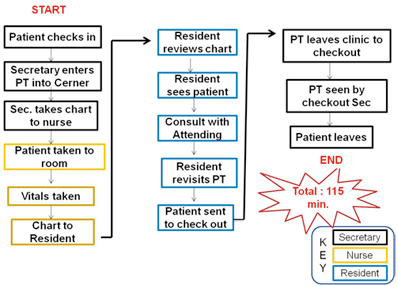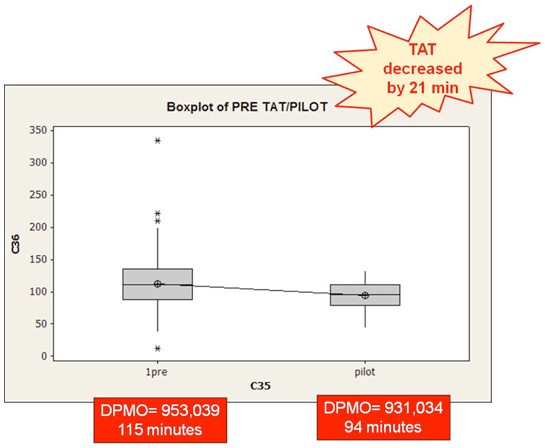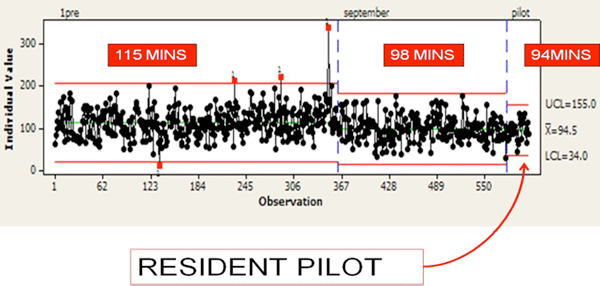
Historically, medical residency teaching clinics provide the heart of medical services to an under-insured population through various government-subsidized health insurance programs. These programs provide medical coverage for eligible individuals with incomes of less than 35 percent of the federal poverty level. It is well-established that people living in poverty are at a higher risk for chronic diseases, such as hypertension, diabetes, dyslipidemia, obesity and psychiatric disorders. Low-income population groups may also experience barriers to receiving healthcare services, such as lack of transportation.
Medical educational residency clinics are challenged to provide accessible, ongoing, quality care while being sensitive to the special needs of the population group they serve. They also must maintain the goal to train new physicians in a fiscally viable manner. Nationally, residency teaching clinics have inefficiencies that cause long patient wait times. Patient wait time for medical care has a direct impact on patient satisfaction, medical compliance, return show rate and patient attitudes toward clinicians, staff and clinics in general.
The Family Ambulatory Health Center (FAHC), located on the main campus of Hurley Medical Center, a public, non-profit teaching medical center in Flint, Mich., consistently scored low in patient wait times on patient satisfaction surveys. Patient wait times to see an internal medicine resident physician in the Hurley FAHC exceeded the patient threshold, causing dissatisfaction, poor medical compliance and high no-show rates. Dissatisfied patients created a domino effect, leading to dissatisfied resident physicians and clinic staff. The resident physicians became frustrated by not being able to manage clinic patients with chronic diseases effectively due to high no-show rates for follow-up appointments. To combat this problem, a Black Belt at the Hurley FAHC began a Six Sigma project.
Define
In January 2010, the Hurley FAHC, in collaboration with North Shore-LIJ Health System, implemented a process improvement project to reduce patient turnaround time (TAT) and improve quality in the internal medicine residency clinic. The project was sponsored by the clinic manager, who monitored the patient satisfaction surveys. The Hurley project was employed to determine clinic inefficiencies and to improve the patient flow process. The premise of this project was that decreased patient wait-times in the internal medicine clinic would increase overall patient satisfaction. The Black Belt leading the project formed a team consisting of a registered nurse, a licensed practical nurse, clerical staff, a nurse practitioner, resident physicians and faculty/clinic physicians. It was important to ensure that the core team and extended members included individuals that have direct contact with the process.
During the Define stage, the team developed a high-level process map to help understand the larger process and to gain consensus for the overall scope of the project (Figure 1).

The process starts when the patient checks in at the registration desk and ends when the patient checks out at the end of the clinic visit. The initial data reflected the total patient visit TAT to be an average of 115 minutes from beginning to end. This process had an upper specification limit (USL) of 60 minutes, which was decided upon by the project sponsor.
Measure
The goal in the Measure phase was to determine a baseline metric of the identified overall Y (TAT) from start to finish. The process map was used to identify each step, and a data collection tool was created to capture a metric for the designated incremental steps within the clinic. The team decided to measure the time required to complete the following process increments:
- Patient checks into the clinic and clerical staff takes chart to holding queue
- Clinical staff brings patient to exam room and puts chart in resident holding queue
- Patient waits in exam for resident physician
- Resident physician sends patient to check out
- Patient waits to be checked out of clinic
Baseline data for the patient TAT in the adult medical clinic was collected from Mar. 8 to Mar. 26, 2010, during each adult medical clinic session in that time frame. The results are represented by the process capability graph in Figure 2.

The sample N was 362 patient visits, which reflected an average TAT of 115 minutes, with a standard deviation of 32.5 minutes. The USL of 60 minutes translated to a baseline defect per million opportunities (DPMO) rate of 953,039 and a corresponding sigma score of -2. Based on these metrics, the Black Belt determined that the process met the customer expectation of a 60-minute turnaround time 4.5 percent of the time.
In keeping with Six Sigma strategy, the team held a brainstorming session with frontline employees to delineate the perceived causes of delay and to get a broad employee prospective of alleged problems in the patient flow process. The perceived causes are represented in the Figure 3.

Analyze
The goal in this phase was to determine which of the identified causes (x’s) of delays in patient TAT had the greatest impact on the total process. This was done by bringing the core group together again to perform a failure mode and effect analysis (FMEA).
Each step of the process was identified and reviewed to determine its failure potential (on a scale of 1 to 10) based on severity, frequency of occurrence and current detection methods. These values were then multiplied to obtain a risk priority number (RPN). The highest values are listed in Table 1.
Table 1: FMEA of Patient Visit Process
| Process Step | Potential Failure | Failure Effects | Sev | Causes | Occ | Current Controls | Det | RPN |
| Patient into room | No room | Patient has to wait | 10 | Too many doctors, too many patients, attending Dr. not available, wait for procedure | 8 | Assign Dr.’s rooms | 1 | 80 |
| Interruptions | Delay getting patient to room | 8 | Prescriptions, phone, paper work, page doctors | 7 | Locked unit doors | 1 | 56 | |
| Resident reviews chart | Chart not complete; Resident not on time | Look up results; Can’t see patient | 10, 7 | Can’t find test results, missing consult letters; Rounding | 8, 7 | No; Schedule | 2, 3 | 160, 147 |
| Revisit | Paper work | More time | 10 | Scripts, forms, referrals, rechecking chart | 10 | No | 1 | 100 |
Further analysis was performed to discern the vital x’s using hypothesis testing to determine statistical significance. The null hypothesis – that there were no statistical differences in TAT between each process step – was rejected because the p-value 0.000 was less than 0.05, indicating that a statistical difference was found between the steps.
Due to the results obtained on the FMEA, the team performed additional analysis on the resident physician and clinician piece of the process. This data reflected that 42 percent and 40 percent of patients’ time was spent with a resident and clinician, respectively.
There also was a statistically significant difference found in the median TAT (p-value of 0.046) between the charts that were reviewed by a resident physician versus charts that were not reviewed by resident physician prior to their clinic time.
Data analysis also showed that the more-experienced resident physicians (PGY 3) had lower median TAT scores with less variation than newer (less experienced) resident physicians (PGY 1), with a significant p-value of 0.000.

In summary, the team determined that the most significant inefficiencies occurred during two time periods:
- The time patients spent waiting in the lobby before being taken to the exam room
- The total time patients spent in the exam room waiting for a resident physician to examine the patient, consult with a faculty physician and close the patient visit.
Improve
The team performed another brainstorming session with representatives from each area where inefficiencies occurred to find solutions that could have a positive impact on patient flow.
The first area of concern was patient wait time in the waiting room. The team found an inadequacy in the check-in process and came up with an easy solution that could be implemented without disrupting staffing boundaries or violating union contracts. This was done by eliminating a step in the check-in process. Prior to the Six Sigma project, patients would sign in and the medical assistants would process their charts. The charts would then need to be carried to the back clinical area to the holding queue for the back-clinic medical assistants to bring patients to examination rooms. The charts were being held in the front check-in area for various extraneous reasons. For instance, the front staff was being interrupted by phone calls, patient walk-ins and other miscellaneous duties.
These disruptions caused a delay in the charts being brought to the back clinical area holding queue. This problem was corrected by keeping a medical assistant in the check-in area to “arrive” patients and attend to all other duties. The check-in clerk was moved to the back clinic area near the holding queue. Under this arrangement, the charts could now be prepped promptly, without interruptions, and put into the holding queue for back-clinic staff to bring patients to the examination rooms.
There also was a delay in the time it took the medical assistant to bring the patient back to the exam room once the patient was registered in the system. In most cases, this delay was directly related to the lack of available exam rooms, which was due to the time resident physicians spent examining preceding patients. It is to be noted that each resident is assigned two exam rooms. The team understood that the rooms needed to be “turned” faster while maintaining quality care. One solution to this problem was an order board posted in a common area to prevent delays in patients waiting for common office procedures such as injections.
Solutions to resident physician-related matters included having resident physicians review patient charts before their clinic day started and to utilize electronic prescription services. As a result, faculty physicians also became more accessible to resident physicians, and resident physicians were educated on how to present a case to faculty in a more concise manner. The schedules for PGY1 resident physicians were adjusted from 15-minute blocks to 30-minute blocks until they became fully oriented to the outpatient clinic.
The team piloted the improvements with a small group of residents. The solutions that they implemented had a positive impact on the process Y by reducing the TAT from the original baseline average of 115 minutes to 94 minutes (an 18 percent reduction), with a corresponding decrease in the variation for the same pilot of residents (Figure 5).

Control
To control and sustain these improvements, the team utilized an individual and moving-range (I-MR) control chart. Monitoring the TAT helped to ensure that the process stayed in control, was stable and met the customer’s expectations.

The team developed a control plan to measure total patient TAT continually and vital x’s for up to one year after the project introduction (Table 2). The management of the Control phase is delegated to a process owner, who is responsible for the day-to-day monitoring and measuring of the process. In this case, the process owner is the registered nurse, who completed Green Belt training and has been directly involved with the project since its inception. The Control phase guarantees continued accountability and allows time for old habits to be dropped and improved habits to be ingrained in the culture of the clinic – from the secretary who checks the patient in to the resident physician.
Table 2: Control Plan for Monitoring Patient TAT
| Description | Data Type | Measurement Method | Control/Monitor | Frequency | Alert Flags | Action | Responsibility | |
| Y | Patient check-in to check-out | Continuous | Manual measurement tool | Control chart | Weekly | Variation in std dev | Review with clinic director | Process owner: Melissa Bachman |
| X | Patient arrived to roomed | Continuous | Cerner | Control chart | Weekly | Variation in std dev | Review with staff | Process owner: Melissa Bachman |
| X | Patient roomed to check-out | Continuous | Cerner/Manual tool | Control chart | Weekly | Variation in std dev | Review with staff | Process owner: Melissa Bachman |
Notable Project Considerations
This project clearly demonstrates the Six Sigma methodology as an effective tool in defining inefficiencies and improving patient flow in a residency outpatient clinic. Six Sigma uses hard data to drive changes rather than notions based on individual perceptions, assumptions and agendas.
Although the team didn’t meet the USL of 60 minutes, set by the project sponsor, the FAHC Internal Medicine Clinic has consistently reduced total patient TAT from 115 minutes to 94 minutes. It should be noted that the baseline data was collected during the time the clinic was functioning optimally. The initial data was collected in March, when the resident physicians were performing at high levels. The PGY 2 and 3 resident physicians were very efficient, due to having two and three years of experience, respectively. The PYG 1 resident physicians were just learning the nuances of primary care or getting a handle on patient management in the outpatient setting. March also is a time when few staff members are on vacation, so the clinic was adequately staffed with seasoned RNs, LPNs, medical assistants and medical secretaries.
The post-solution measurement phase occurred during the most hectic time for an outpatient residency clinic; it coincided with the graduation of PGY 3 resident physicians. PGY3 residents were focused on terminating patient relationships, writing clinic summaries and tying up loose ends. As PGY 3 resident physicians are graduating, PGY 1 resident physicians are entering the program and going through orientation. Given the challenges during this time, the team worked extremely well in keeping the process intact.
In retrospect, the team should consider whether the USL of 60 minutes set by the project sponsor was a reasonable and achievable goal for an outpatient residency clinic. In 2006, the national average for time that a seasoned physician spent with a patient was close to 22 minutes. Given the complexity of care that the FAHC patients require, it should be expected that resident physicians would spend more time with patients than their seasoned clinician cohorts.
The goal of this project was to enhance the physician training process by increasing clinic proficiency while maintaining quality patient care. We succeeded in cutting back patient wait-times in certain key steps of the process. The project decreased the amount of time patients wait in the lobby (main waiting area) by 38 percent. In keeping with recommendations set by the Institute of Medicine, our patients wait an average of 18 minutes in the lobby after they check in to the clinic. This group recommends that 90 percent of scheduled patients should be seen within 30 minutes of their scheduled appointment. The project work decreased the amount of time the patient waits for medical services while maintaining the amount of time the resident physician spends with the patient.
In conclusion, the FAHC Internal Medicine Clinic reduced patient total TAT by 18 percent without compromising patient care. We expect to see improved patient satisfaction, improved resident physician satisfaction and improved continuity of care for our clinic patients with the improved process flow implemented through this Six Sigma project.
Acknowledgements
Beth Friedt, MT (ASCP)
Interim Administrative Director of the Clinical Laboratory
Master Black Belt
Aaron Moses, BS, MT (ASCP)
Laboratory Services Coordinator
Black Belt
Melissa Bachman, RN
Family Ambulatory Health Center
Green Belt
References
Cole, F.L., Mackey, T.A., & Lindenberg, J. (2001). Wait time and Satisfaction with Care and
Service at a Nurse Practitioner Managed Clinic. Journal of the American Academy of Nurse Practitioners, 13, 467-472.
Dansky, K.H., & Miles, J. (1997). Patient Satisfaction with Ambulatory Healthcare Services:
Waiting Time and Filling Time. Hospital & Health Services Administration, 42, (2) 165-177.
Mackey, T. A., & Cole, F. (1997). Patient Waiting Times in a Nurse Managed Clinic.
The Internet Journal of Advanced Nursing Practice, 1, (1). Retrieved October 1, 2010.
Mauksch, L., Katon, W., Russo, J., Tucker S., & Walker E. (2003). The Content of a Primary
Care Population: Including the Patient Agenda. Journal of the American Board of Family Practice, 16, (4), 279-289.
Xakellis, G., C., & Bennett, A. (2001). Improving Clinic Efficiency of a Family Medicine
Teaching Clinic. Family Medicine, 33, (7), 533-538.